INSTITUT SUPERIEUR D'ANTHROPOLOGIE
INSTITUTE OF ANTHROPOLOGY
ONLINE COURSES / COURS A DISTANCE
INSCRIPTION 2012 / Session III : Juillet 2012
REGISTRATION 2012 / Term III : July 2012
ROYAUME UNI - 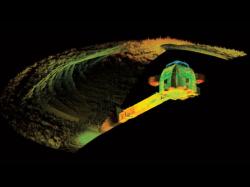 - Maeshowe - A team of Scottish archaeological surveyors have used laser scanning technology to virtually uncover early settlements on Orkney that date back more than 5,000. The surveyors, from the Glasgow School of Art's Digital Design Studio and the government agency Historic Scotland, used high tech equipment – including scanners from Leica Geosystems – to document historic chambers. One of the targeted structures was Maeshowe, a 3.8-metre-tall stone chamber buried under a mound of earth and only accessible through an 11-metre-long narrow passage. The Neolithic monument has been comprehensively scanned as part of the Scottish Ten project, in which the group of surveyors are surveying ten World Heritage Sites across the globe. The scan of Maeshowe was able to measure the ancient structure to accuracy of within six millimetres. They hope that the scans will help with the conservation of the site and serve to monitor future wear and tear. The scanning of Maeshowe has also documented the largest known collection of runes outside of Scandinavia, which were deposited in the tomb around one thousand years ago when Orkney was under the rule of the Norwegians. Other World Heritage Sites that have already been scanned as part of the project include Mount Rushmore in the US and the island of St Kilda, off the north west coast of Scotland.
- Maeshowe - A team of Scottish archaeological surveyors have used laser scanning technology to virtually uncover early settlements on Orkney that date back more than 5,000. The surveyors, from the Glasgow School of Art's Digital Design Studio and the government agency Historic Scotland, used high tech equipment – including scanners from Leica Geosystems – to document historic chambers. One of the targeted structures was Maeshowe, a 3.8-metre-tall stone chamber buried under a mound of earth and only accessible through an 11-metre-long narrow passage. The Neolithic monument has been comprehensively scanned as part of the Scottish Ten project, in which the group of surveyors are surveying ten World Heritage Sites across the globe. The scan of Maeshowe was able to measure the ancient structure to accuracy of within six millimetres. They hope that the scans will help with the conservation of the site and serve to monitor future wear and tear. The scanning of Maeshowe has also documented the largest known collection of runes outside of Scandinavia, which were deposited in the tomb around one thousand years ago when Orkney was under the rule of the Norwegians. Other World Heritage Sites that have already been scanned as part of the project include Mount Rushmore in the US and the island of St Kilda, off the north west coast of Scotland.
http://www.surveyequipment.com/news/article/laser-scanning-documents-ancient-scottish-settlements-183558.html
FRANCE - 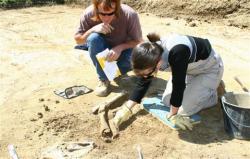 Châtenois-les-Forges -Une équipe de l’Institut national de recherches archéologiques préventives (Inrap) a investi un terrain à proximité de l’église. Sa mission : fouiller des vestiges datant du Moyen Âge. Les traces, en fait, de ce qui allait devenir Châtenois-les-Forges
Châtenois-les-Forges -Une équipe de l’Institut national de recherches archéologiques préventives (Inrap) a investi un terrain à proximité de l’église. Sa mission : fouiller des vestiges datant du Moyen Âge. Les traces, en fait, de ce qui allait devenir Châtenois-les-Forges
http://www.lepays.fr/territoire-de-belfort/2012/05/15/fouilles-des-vestiges-du-village-d-origine
ROYAUME UNI – 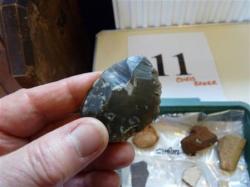 Clavering - Villagers dug deep to discover Clavering’s hidden history at the weekend. In all, 27 households took part in a special ‘Dig and Sow’ event in the parish led by Cambridge University archaeologist and former Time Team presenter Carenza Lewis. Among the artefacts unearthed were bits of pottery from the medieval to Victorian eras, animal bone, a medieval bell which was possibly used on a dog collar, a trading token dated 1669 and remains of a commemorative cup from the 1700s which was probably commissioned especially for a christening or wedding. One of the most exciting finds was what is believed to be a prehistoric leaf-shaped arrowhead, up to 6,000 years old, although experts are yet to confirm this officially.
Clavering - Villagers dug deep to discover Clavering’s hidden history at the weekend. In all, 27 households took part in a special ‘Dig and Sow’ event in the parish led by Cambridge University archaeologist and former Time Team presenter Carenza Lewis. Among the artefacts unearthed were bits of pottery from the medieval to Victorian eras, animal bone, a medieval bell which was possibly used on a dog collar, a trading token dated 1669 and remains of a commemorative cup from the 1700s which was probably commissioned especially for a christening or wedding. One of the most exciting finds was what is believed to be a prehistoric leaf-shaped arrowhead, up to 6,000 years old, although experts are yet to confirm this officially.
http://www.hertsandessexobserver.co.uk/Dunmow-Stansted/Slideshow-Clavering-residents-dig-deep-into-their-history-15052012.htm
GRECE - 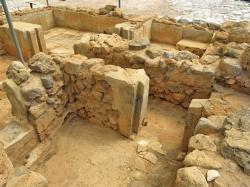 Héraklion : découverte d'un bâtiment public minoen en liaison avec le site de Cnossos
Héraklion : découverte d'un bâtiment public minoen en liaison avec le site de Cnossos
http://www.tovima.gr/culture/article/?aid=456725
EGYPTE –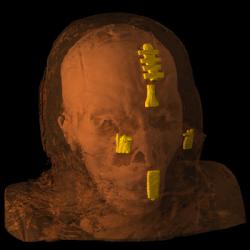 Rhind mummy - Egyptian Mummies shrouded for over 2000 years could be set to give up their inner secrets like never before. Thanks to a 3D hologram imaging process developed by Edinburgh-based Holoxica, the Rhind Mummy has been revealed in true 3D. Originally excavated from a tomb in Thebes (Luxor) almost 155 years ago, the Rhind Mummy – so named after the renowned Scottish Archaeologist and Egyptologist Alexander Rhind who brought the mummy to Scotland in the middle of the 19th Century – is completely intact in its original black-tarred linen wrapping. The mummy has been in the National Museum of Scotland’s collection ever since. Until recently, no one knew what was contained inside the shroud, but a series of CT scans at Edinburgh Royal Infirmary carried out by the University of Edinburgh’s Clinical Research Imaging Centre (CRIC) showed the revelations were nothing sort of startling – the CT scans revealed the mummy was an Egyptian female aged 25-29, 5ft 2 ins tall, dating back to around 10BC. She was revealed to hold a papyrus scroll in her right hand, the so-called Book of Breathing, with instructions to help her on the journey into the afterlife. The cause of death is still unknown, although medical experts believe it could be an infection followed by untreatable pneumonia. the first layer is the wrapping shroud, which ‘peels’ away to reveal her face. This is followed by the skull. The ‘outer wrapping’ is encrusted with jewels and gold amulets which are visible from angles and, most intriguingly, a metal scarab-shaped cap was placed on top of the skull during mummification, can also be seen in great detail.
Rhind mummy - Egyptian Mummies shrouded for over 2000 years could be set to give up their inner secrets like never before. Thanks to a 3D hologram imaging process developed by Edinburgh-based Holoxica, the Rhind Mummy has been revealed in true 3D. Originally excavated from a tomb in Thebes (Luxor) almost 155 years ago, the Rhind Mummy – so named after the renowned Scottish Archaeologist and Egyptologist Alexander Rhind who brought the mummy to Scotland in the middle of the 19th Century – is completely intact in its original black-tarred linen wrapping. The mummy has been in the National Museum of Scotland’s collection ever since. Until recently, no one knew what was contained inside the shroud, but a series of CT scans at Edinburgh Royal Infirmary carried out by the University of Edinburgh’s Clinical Research Imaging Centre (CRIC) showed the revelations were nothing sort of startling – the CT scans revealed the mummy was an Egyptian female aged 25-29, 5ft 2 ins tall, dating back to around 10BC. She was revealed to hold a papyrus scroll in her right hand, the so-called Book of Breathing, with instructions to help her on the journey into the afterlife. The cause of death is still unknown, although medical experts believe it could be an infection followed by untreatable pneumonia. the first layer is the wrapping shroud, which ‘peels’ away to reveal her face. This is followed by the skull. The ‘outer wrapping’ is encrusted with jewels and gold amulets which are visible from angles and, most intriguingly, a metal scarab-shaped cap was placed on top of the skull during mummification, can also be seen in great detail.
http://www.photonicsonline.com/